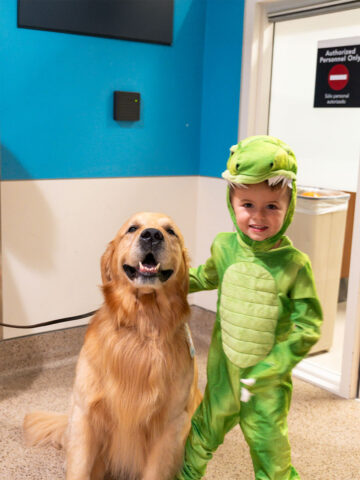By Dr. Marni Nagel, pediatric psychologist at CHOC
It is normal for children to have fears. Some kids are afraid of the dark, some are afraid of monsters and others are afraid of masks. We are experiencing an unprecedented time, full of uncertainty, which can make previous fears even stronger or bring on new ones.
The Centers for Disease Control has recently recommended that children over the age of 2 years and adults wear masks in all public spaces. Some children may incorporate mask wearing into their daily lives with ease, while others may find it odd, uncomfortable or even scary. If your child is having trouble wearing a mask, here are some tips on how to ease their fears:
Explain the why
- Explain why you want your child to wear a mask using short, clear words, making sure that you use language that your child can easily understand. You might say, “Putting on this mask helps your body stay healthy. It also helps other people stay safe and healthy.”
- If children want more information, answer their questions.
Get creative
- Show your child pictures or videos of other children wearing masks and having fun.
- Be creative with your masks by having your child choose the color, pattern, design or fabric. Depending on the type of mask, you can even put stickers, sequins or gems/rhinestones on them to decorate. The more your child is involved in creating the mask, the better.
- Children can draw pictures or write stories about characters wearing masks and having fun or doing important jobs.
- Engaging in fun activities while wearing masks can help distract your child so that they might not even notice that they have a mask on after awhile. You can play games, color, read books, dance, or do any other activity that you like.
- You can use masks during pretend play to be their favorite superhero or animal. Children may want to wear their masks more if it helps them to get into character. They can also put masks on their favorite stuffed animals and dolls, perhaps even having matching ones for themselves.
Give your child a sense of control and accomplishment
- Have your child choose a couple of masks that they really like and then before wearing a mask, they can choose which one they want to wear that day. You can also then ask, “Which mask do you want to wear today?” instead of asking, “Do you want to put on your mask?” Don’t give children a choice where none exists, such as wearing a mask in the first place. Allowing a child to choose which mask they would like to wear gives your child some control which can help increase comfort.
- To increase a child’s sense of control, they can also select a mask for you to wear when you leave the house together.
- Make sure to praise your child when they do a great job wearing their mask. They will feel proud of themselves when you acknowledge their accomplishment.
- Children can also earn a reward when they wear their masks when asked. Find a reward that your child would like and that is reasonable for you to provide, such as a special activity with you, bonus time playing their favorite game, or picking their favorite food for dinner. The closer in time that you can give the reward to the mask wearing, the better.
Practice makes perfect
- Model for children how and when to wear masks by setting an example yourself.
- Practicing wearing masks before you need to helps the mask not seem so strange or unusual. If they have trouble putting one on, have them start with a favorite toy or doll.
If you sense that your child is afraid, here are some additional ways you can help them feel more comfortable wearing a mask amid the COVID-19 pandemic.
- Encourage your child to express their fears and let them know that everyone feels happy, sad, angry and worried sometimes — even parents.
- Listen to what your child has to say and let them know that it is ok to feel that way.
- Comfort your child by letting them know that you are here and ready to help. Often holding their hand or giving a hug is reassuring.
- Help calm your child down by taking a deep breath and counting to three
- Use positive self-statements. Teach your child to say, “I can do this. I am going to be OK.”
- Start off small when practicing. Determine what your child is comfortable with, such as holding the mask in their hand or holding the mask to their face but not securing it in place and start there. Provide them with an enjoyable activity to do while practicing.
- Give plenty of opportunities to practice.
This article was last updated on May 18, 2020.
Get more expert health advice delivered to your inbox monthly by subscribing to the KidsHealth newsletter here.
Get mental health resources from CHOC pediatric experts
The mental health team at CHOC curated the following resources on mental health topics common to kids and teens, such as depression, anxiety, suicide prevention and more.





